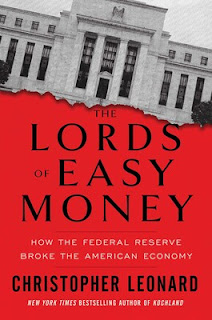 author of The Lords of Easy Money: How the Federal Reserve Broke the American Economy, The Meat Racket, and Kochland, which won the J. Anthony Lukas Work-in-Progress Award.
author of The Lords of Easy Money: How the Federal Reserve Broke the American Economy, The Meat Racket, and Kochland, which won the J. Anthony Lukas Work-in-Progress Award.
Leonard applied the “Page 99 Test” to The Lords of Easy Money and reported the following:
If readers were to flip to page 99 of The Lords of Easy Money, they would read a story that illuminates one of the most important themes of the whole book. They would see how leaders of the Federal Reserve bank project an aura of infallibility, even as they make colossal mistakes.Visit Christopher Leonard's website.
Page 99 recounts an episode in March of 2007, when the U.S. was on the precipice of the worst economic catastrophe since the Great Depression. Ben Bernanke, the chairman of the Federal Reserve System, was called before Congress and asked to explain what was going on. Bernanke was assumed to be not just intelligent, but almost oracular in his powers of observation. He spoke in the rarified and expert language of an economic high priest. It carried a lot of weight, then, when he told the nation that there was nothing to see here. The Fed had been stoking the housing market for many years with easy money policies that kept interest rates extraordinarily low, and the money was sloshing into cheap loans for expensive houses and pumping up risky debt like “subprime” mortgages that were beginning to default in large numbers. But Bernanke assured lawmakers that the Fed had everything under control.
“The principal source of the slowdown in economic growth that began last spring has been the substantial correction in the housing market,” Bernanke calmly explained. “At this juncture, however, the impact on the broader economy and financial markets of the problems in the subprime market seems likely to be contained.”
Needless to say, the problems were not contained. Within a matter of months, the global financial system started to short-circuit under the weight of unsustainable debt and speculative derivatives investments.
Bernanke’s testimony on that day was not an isolated incident. It tells a bigger story about the power of the Federal Reserve bank. The institution has become increasingly important to American economic life, expanding its interventions and its powers. And as this has happened, the Fed’s leaders, like Ben Bernanke, have increasingly cocooned their decision making behind a thick wall of incomprehensible jargon and exaggerated complexity, a language that has come to be known as “Fed Speak.”
The first goal of Fed Speak is to make ordinary citizens believe that the politics of money creation is so sophisticated that it can only be handled by a small group of PhD-educated economists. The second goal is to make the Fed’s leadership team appear to be infallible, as if they are simply solving math equations rather than making policy decisions based on hunches.
The record in support of Fed infallibility is not encouraging. A review of internal transcripts and interviews with senior Fed policy makers show that the central bank has been repeatedly wrong in forecasting the effects of its own interventions. An internal 2012 Fed forecast used to justify $1.6 trillion in new money printing, called “quantitative easing,” was catastrophically wrong in predicting such important measures as future interest rates and inflation. In an internal meeting, Bernanke admitted that more quantitative easing was “a shot in the proverbial dark,” a view that was contrary to his public statements extolling the soundness of the plan.
The Fed is once again assuring the public that it has things firmly under control as inflation burns hot and newly inflated debt instruments, such as corporate junk bonds, reach sky-high levels. The record shows that we should be deeply skeptical.
The Page 99 Test: The Meat Racket.
--Marshal Zeringue



